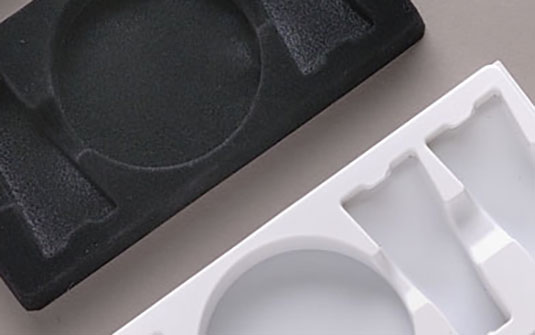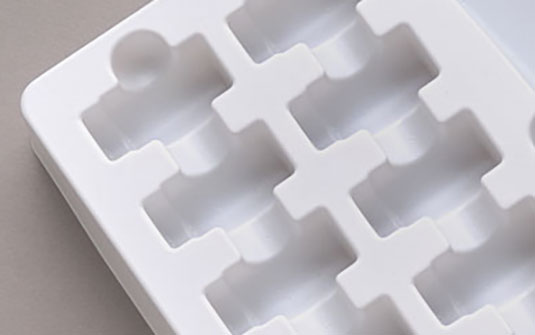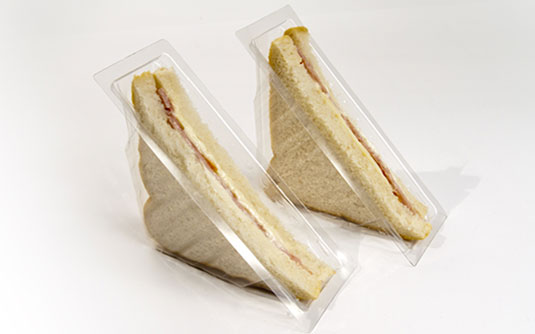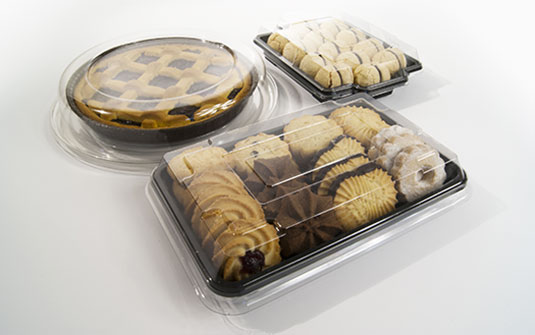
PLASTECO: PERSONALISED THERMOFORMING FOR AN IRRESISTIBLE PACKAGING!
Thermoforming is a technique of moulding plastic materials of various types and always takes place by the application of heat. Usually, it starts with slabs or film and it has been demonstrated to be an exceptional alternative to the classic injection method, especially if the production runs are limited in terms of quantities.
Thermoforming can be obtained in two ways: vacuum or under pressure.
What is vacuum thermoforming?
Vacuum thermoforming is the term used when the preheated plastic material is placed on the mould purely by suction through the micro holes created on the mould. The semi-processed material is forced to stick to a concave shape through the creation of a vacuum inside the cavity itself.
This technique can always be used but is mostly chosen when the thicknesses are limited and the shapes reasonably simple.
What is thermoforming under pressure?
In thermoforming under pressure, the plastic film, again preheated, is forced onto the mould thanks to high pressure exerted from the outside, which improves the forming of the pieces and reduces the production times.
In both cases, for improving the resistance of the thermoformed blister, a counter mould can be used: this is a mechanical aid operated by presses that “force” the material into the deepest cavities.

PLASTECO THERMOFORMING? MAXIMUM EXCELLENCE, MAXIMUM CUSTOMISATION!
PLASTECO used thermoforming to create thermoformed products and made to measure moulds of all types, such as, for example:
- Packages
- Containers
- Platters
- Packaging
- Trays
- Interiors for cosmetics
- Blister packs
- Interiors of boxes
- Display cases
CLASSIC THERMOFORMING
Thermoforming by positive mould is the term used when the plastic material is forced to adhere to a convex shape through the creation of a vacuum at appropriate points of the mould.
This method, while having limitations in the depth of moulding, enables the thermoforming of semi-processed material with greater thickness since, in addition to the vacuum, additional pressure is applied through the interference of the plane of the clamping frame with the mould.
In negative mould thermoforming, the heated plastic material is made to adhere to a concave shape through the creation of the vacuum, if necessary with the aid of air pressure.
In certain cases, when the depth of the piece is very great, a counter mould in wood or resin is used, depending on the production requirements, with the following functions.
- They help distribute the heated material in deep cavities without excessive stretching
- They improve the robustness of the thermoformed product, so the material is not too thin.
They avoid the formation of the so-called “flaws” that tend to form in the areas with restricted spaces of the mould or between the various elements of a multiple imprint mould.
And positive-negative mould thermoforming?
Positive-negative mould thermoforming is a compromise between the two previous systems; in it, the semi-processed material is forced to adhere to a positive and negative shape with regard to the plane of the clamping frame, again through the creation of a vacuum at appropriate points of the mould; the advantage of this method lies essentially in the greater depth.
The separation of the moulded model from the rest of the frame takes place in two ways: by means of the use of shaped punches, often heated (which is the most widespread method) or by means of the use of the technique of slice-forming. In this latter case, the separation takes places inside the mould thanks to blades that are operated when it is still closed, but in any event when the material has already been formed.
The time and mode of exposure to cooling of the thermoformed object and the right sequence of the various production steps contribute to the dimensional precision of the object.
In order to guarantee a sufficiently rigid structure of the thermoformed object, the ribbing is designed to run along and intertwine with the object itself, mediating between functionality and aesthetics. These aspects are today designed on computer, using specific software applications that are also able to calculate the probability of breakage.
Do you want high-quality personalised production in rapid times?
Contact us right away: our staff are at your disposal for a consultation without commitment.



